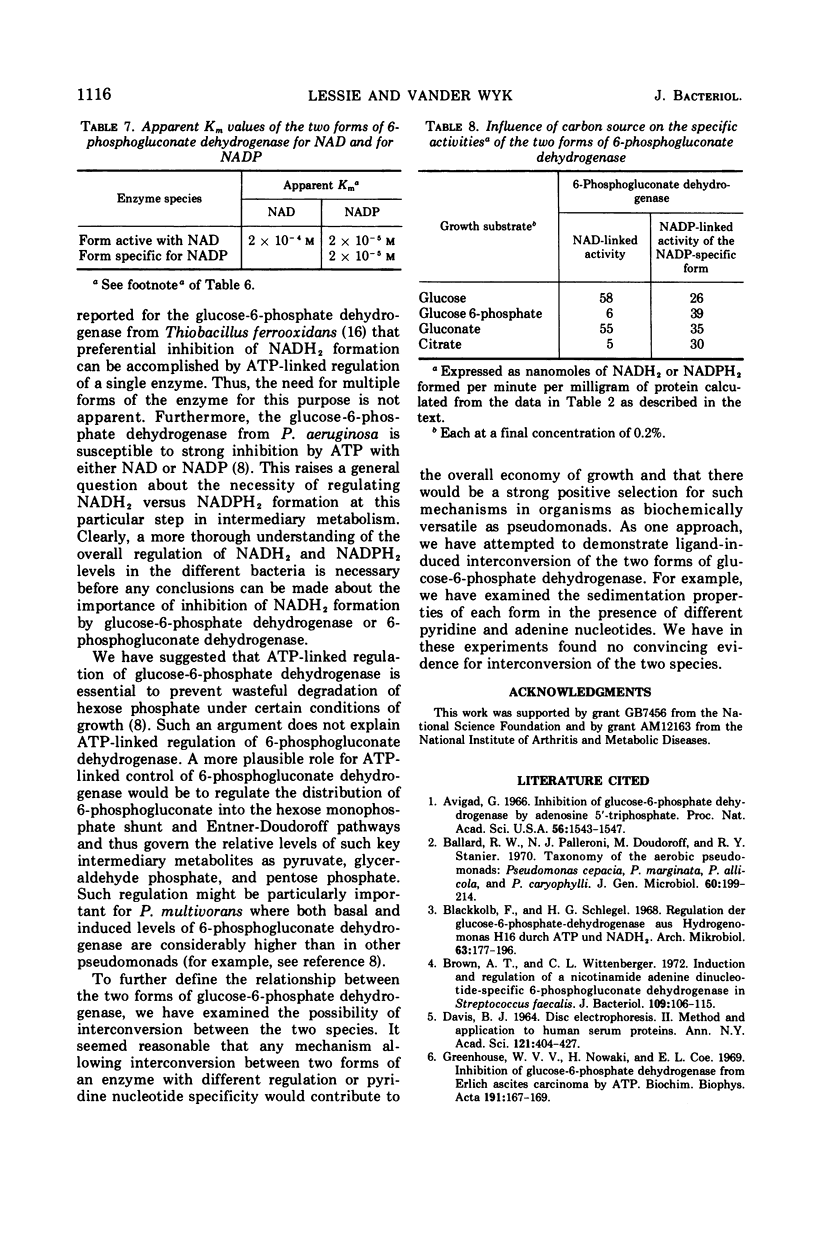Abstract
Two major species of glucose-6-phosphate dehydrogenase (EC 1.1.1.49) differing in size, pyridine nucleotide specificity, and susceptibility to inhibition by adenosine 5′-triphosphate (ATP) were detected in extracts of Pseudomonas multivorans (which has recently been shown to be synonymous with the species Pseudomonas cepacia) ATCC 17616. The large species (molecular weight ca. 230,000) was active with nicotinamide adenine dinucleotide (NAD) or nicotinamide adenine dinucleotide phosphate (NADP) and was markedly inhibited by ATP, which decreased its affinity for glucose-6-phosphate and for pyridine nucleotides. This form of the enzyme exhibited homotropic effects for glucose-6-phosphate. The small species (molecular weight ca. 96,000) was active with NADP but not with NAD, was not inhibited by ATP, and exhibited no homotropic effects for glucose-6-phosphate. Under certain conditions multiplicity of 6-phosphogluconate dehydrogenase (EC 1.1.1.43) activities was also noted. One form of the enzyme (80,000 molecular weight) was active with either NAD or NADP and was inhibited by ATP, which decreased its affinity for 6-phosphogluconate. The other form (120,000 molecular weight) was highly specific for NADP and was not susceptible to inhibition by ATP. Neither form of the enzyme exhibited homotropic effects for 6-phosphogluconate. The possible relationships between the different species of glucose-6-phosphate dehydrogenase and 6-phosphogluconate dehydrogenase are discussed.
Full text
PDF










Images in this article
Selected References
These references are in PubMed. This may not be the complete list of references from this article.
- Avigad G. Inhibition of glucose 6-phosphate dehydrogenase by adenosine 5'-triphosphate. Proc Natl Acad Sci U S A. 1966 Nov;56(5):1543–1547. doi: 10.1073/pnas.56.5.1543. [DOI] [PMC free article] [PubMed] [Google Scholar]
- Ballard R. W., Palleroni N. J., Doudoroff M., Stanier R. Y., Mandel M. Taxonomy of the aerobic pseudomonads: Pseudomonas cepacia, P. marginata, P. alliicola and P. caryophylli. J Gen Microbiol. 1970 Feb;60(2):199–214. doi: 10.1099/00221287-60-2-199. [DOI] [PubMed] [Google Scholar]
- Blackkolb F., Schlegel H. G. Regulation der Glucose-6-phosphate-Dehydrogenase aus Hydrogenomonas H 16 durch ATP und NADH. Arch Mikrobiol. 1968;63(2):177–196. [PubMed] [Google Scholar]
- Brown A. T., Wittenberger C. L. Induction and regulation of a nicotinamide adenine dinucleotide-specific 6-phosphogluconate dehydrogenase in Streptococcus faecalis. J Bacteriol. 1972 Jan;109(1):106–115. doi: 10.1128/jb.109.1.106-115.1972. [DOI] [PMC free article] [PubMed] [Google Scholar]
- DAVIS B. J. DISC ELECTROPHORESIS. II. METHOD AND APPLICATION TO HUMAN SERUM PROTEINS. Ann N Y Acad Sci. 1964 Dec 28;121:404–427. doi: 10.1111/j.1749-6632.1964.tb14213.x. [DOI] [PubMed] [Google Scholar]
- Greenhouse W. V., Nowaki H., Coe E. L. Inhibition of glucose-6-phosphate dehydrogenase from Ehrlich ascites carcinoma by ATP. Biochim Biophys Acta. 1969 Sep 30;191(1):167–169. doi: 10.1016/0005-2744(69)90328-3. [DOI] [PubMed] [Google Scholar]
- Hedrick J. L., Smith A. J. Size and charge isomer separation and estimation of molecular weights of proteins by disc gel electrophoresis. Arch Biochem Biophys. 1968 Jul;126(1):155–164. doi: 10.1016/0003-9861(68)90569-9. [DOI] [PubMed] [Google Scholar]
- LOWRY O. H., ROSEBROUGH N. J., FARR A. L., RANDALL R. J. Protein measurement with the Folin phenol reagent. J Biol Chem. 1951 Nov;193(1):265–275. [PubMed] [Google Scholar]
- Lessie T. G., Whiteley H. R. Properties of threonine deaminase from a bacterium able to use threonine as sole source of carbon. J Bacteriol. 1969 Nov;100(2):878–889. doi: 10.1128/jb.100.2.878-889.1969. [DOI] [PMC free article] [PubMed] [Google Scholar]
- Lessie T., Neidhardt F. C. Adenosine triphosphate-linked control of Pseudomonas aeruginosa glucose-6-phosphate dehydrogenase. J Bacteriol. 1967 Apr;93(4):1337–1345. doi: 10.1128/jb.93.4.1337-1345.1967. [DOI] [PMC free article] [PubMed] [Google Scholar]
- MARTIN R. G., AMES B. N. A method for determining the sedimentation behavior of enzymes: application to protein mixtures. J Biol Chem. 1961 May;236:1372–1379. [PubMed] [Google Scholar]
- Ohmann E., Borriss R., Rindt K. P. Glucose-6-phosphat-Dehydrogenase in autotrophen Mikroorganismen. II. Die Regulation der Aktivität der Glucose-6-phosphat-Dehydrogenase in Euglena gracilis und Rhodopseudomonas spheroides. Z Allg Mikrobiol. 1970;10(1):37–53. doi: 10.1002/jobm.3630100104. [DOI] [PubMed] [Google Scholar]
- Sanwal B. D. Regulatory mechanisms involving nicotinamide adenine nucleotides as allosteric effectors. 3. Control of glucose 6-phosphate dehydrogenase. J Biol Chem. 1970 Apr 10;245(7):1626–1631. [PubMed] [Google Scholar]
- Schindler J., Schlegel H. G. Regulation der Glucose-6-phosphat-Dehydrogenase aus verschiedenen Bakterienarten durch ATP. Arch Mikrobiol. 1969;66(1):69–78. [PubMed] [Google Scholar]
- Tabita R., Lundgren D. G. Glucose-6-phosphate dehydrogenase from the chemolithotroph Thiobacillus ferrooxidans. J Bacteriol. 1971 Oct;108(1):343–352. doi: 10.1128/jb.108.1.343-352.1971. [DOI] [PMC free article] [PubMed] [Google Scholar]
- Tiwari N. P., Campbell J. J. Enzymatic control of the metabolic activity of Pseudomonas aeruginosa grown in glucose or succinate media. Biochim Biophys Acta. 1969 Dec 30;192(3):395–401. doi: 10.1016/0304-4165(69)90388-2. [DOI] [PubMed] [Google Scholar]



